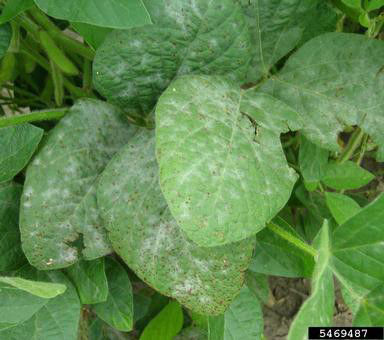Powdery Mildew in Soybeans
October 11, 2019

Powdery mildew in soybeans, caused by the fungus Microsphaera diffusa, is a leaf disease that also affects other legumes. The disease requires cool air temperatures and low relative humidity, making it uncommon during Midwest summers. Powdery mildew occurs occasionally in soybeans in the Midwest and upper Midwest. Although epidemics have been reported about every 10 to 15 years, outbreaks have become more common as seeding rates have increased and row spacing has decreased. Powdery mildew can cause significant yield loss when it occurs, so it’s important for farmers to watch their fields for signs of the disease.
Late-planted soybeans are at greater risk of powdery mildew infection. The disease may be a concern in Midwestern states during certain years when temperatures are cooler than normal from soybean flowering to maturity.
Identification and Lifecycle
Powdery mildew first appears as small circular areas of white, powdery mold growth on the upper soybean leaf surface. Infected areas enlarge to cover more area of the leaf, including upper and lower leaf surfaces. Powdery mildew may also develop on stems and pods. During heavy infections, all above-ground portions of the soybean plant are covered with the white to light-gray powdery mold.
Some soybean varieties may exhibit chlorosis, or yellowing, of leaves and rusty patches on the underside of leaves. Heavily infected plants may defoliate prematurely. Heavily infected pods typically contain shriveled, undeveloped, deformed and flattened green seeds.
The powdery mildew fungus lifecycle begins when microscopic asexual spores (conidia) are dispersed by wind, land on soybean leaves, germinate and penetrate the leaves. These spores form germ tubes and attach themselves to the leaf cells via an anchorage structure. Eventually, this gives rise to feeding structures that develop chains over the soybean leaf. Windborne spores start new infections and repeat the disease cycle until soybean plants mature.
Cooler-than-normal temperatures – 65 to 77 degrees F – favor development of powdery mildew. Disease development is constrained in temperatures above 86 degrees F. Rainfall doesn’t seem to impact the disease. Although soybean plants are susceptible at any growth stage, symptoms are rare before the mid- to late-season reproductive stages.
Crop Damage
Powdery mildew causes soybean crop damage when infected leaves inhibit photosynthesis, transpiration (water uptake through roots and evaporation on leaves) and use of nutrients. Measured yield losses of up to 10 bushels per acre were estimated in Iowa studies over a three-year period and up to 5 bushels per acre in Wisconsin. Yield loss will be greater in soybeans planted late for a region than in early-planted soybeans.
Managing Powdery Mildew in Soybeans
Farmers can manage powdery mildew outbreaks in soybeans through variety selection, scouting, cultivation and fungicides. These best management practices also help minimize the potential for fungicide resistance. Following seasonal reports on disease occurrences from county Extension agronomists is another helpful practice.
Variety selection
No soybean variety is completely resistant to powdery mildew, but some varieties are much more susceptible than others. It’s difficult for companies to evaluate and breed for resistance because, in most years, powdery mildew pressure is low or nonexistent in soybean fields. It’s always wise to plant disease-free seed. Good weed control from preplant, at planting and throughout the growing season also helps protect against diseases and other pests.
Scouting
When scouting soybean fields for weeds and insects, check for the presence of powdery mildew and other foliar diseases. During cooler-than-normal seasons when the crop is in the mid- to late reproductive stage, look for powdery mildew symptoms. Take particular care to check the upper surfaces of leaves midway through the canopy. If you suspect powdery mildew, take samples and send them to the diagnostic lab recommended by your county Extension, or refer to a pest identification guide.
Cultural practices
Crop rotation is not an effective practice to manage powdery mildew because the windborne fungus can spread over long distances. Tillage after harvest and before planting can help break down crop residue and destroy disease pathogens.
Fungicides
If powdery mildew presents a heavy infection in soybeans, a timely fungicide application after flowering (R1 growth stage) may be warranted. Check for fungicides that are labeled for powdery mildew control. Always use full recommended rates and follow label directions.
Bayer solutions to control diseases in soybeans
A fungicide seed treatment can provide a healthy start for seedlings. Multiple fungal pests can impact soybean seeds and seedlings immediately after planting, and EverGol® Energy SB can protect against pests causing the most damage such as Rhizoctonia solani, Fusarium spp and Pythium spp.
Also, timely foliar fungicide applications help protect soybean plants from fungal diseases, including powdery mildew, through the season. For farmers, a fungicide decision is a matter of considering production needs, past history in the fields, commodity prices, proper timing and risk management.
Delaro® fungicide offers unmatched broad-spectrum control. Its advanced formulation delivers best-in-class dual mode of action residual and improved plant health. In soybeans, the ideal time to first apply Delaro is prior to disease development, between R2 and R5, with applications repeated as necessary. Disease-susceptible cultivars and seed soybeans are most likely to benefit from a Delaro application. For cost efficiency, Delaro can be tankmixed with insecticides and applied in the same trip across the field.
Before applying any fungicide, please read the entire label for the best possible results and to confirm that the product is effective on the disease you need to control. Not every product is suitable for every situation, and correct application technique will ensure the best results.